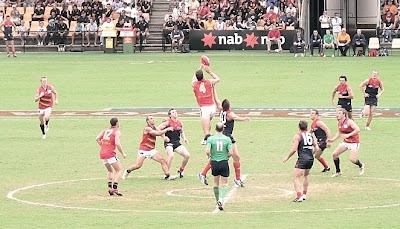 |
| A football oval with the playing positions listed |
The game stars with a coin toss to determine beginning directions. Then the ball is bounced in the centre of the field by an umpire and one team member from each side jumps for the ball and attempts to knock it towards another team member to gain possession. There are positions for players on the field but all players are free to move anywhere on the field during the game.
Scoring might seem a little weird to people new to the game. The aim is to kick the ball between the other teams posts. There are 4 posts at each end of the field. One team aims for one set of posts and vice versa. The teams interchange which direction they kick each quarter. When the ball is kicked between the two big (centre) posts that is a 'goal' which scores 6 points. If the ball is kicked between a small and big post (outer posts) that is a 'behind' which is 1 point. If the ball goes through any of the posts but makes contact with the defending team before crossing the line it is only 1 point even if it goes through the centre posts. If a team scores a goal the ball is returned to the centre of the field to begin play with a bounce. If only a behind (point) is scored the defending team then starts with the ball at their goal line between the centre posts.
Players are allowed to tackle the player that is in possession of the ball. If the player that is tackled does not handpass or kick the ball before getting pulled to the ground a free kick is awarded to the opposing team. If the player getting tackled drops or throws the ball a free kick is awarded. Although tackles are allowed, tackles that are considered too high (grabbing around the neck or head) are against the rules and a free kick will be awarded to the player that was tackled. Pushing in the back is also against the rules but a clean tackle from behind is fine though.
Marking the ball is another rule that some people do not understand at first. A mark is when a player catches the ball directly from a kick from either a team mate or the opposition. If the kick travels over 15m (distance is estimated at the discretion of the umpires) before being marked, the player has the option to pay the mark (basically take a free kick) or to play on. If the player takes the mark he will usually stop when he marks the ball and if an opposing player is about to tackle him he may do something to indicate he is taking the mark such as stop and stick out his hand or something. If the player marks the ball while being tackled or while diving or falling it is usually just considered that he will take the mark. When a player takes the mark the opposition are not allowed to tackle the player, the player is free for 10-15 seconds or so to kick the ball (usually the umpires will allow more time if the playing is going for a kick for goal, particularly for a long distance or hard angle kick). If the player decides to run with the ball that is considered a play on and he can now be tackled.
For more info check the Wikipedia pages:
http://en.wikipedia.org/wiki/Australian_rules_football
http://en.wikipedia.org/wiki/Laws_of_Australian_football
http://en.wikipedia.org/wiki/Australian_rules_football_tactics_and_skills
Here are the highlights from the Grand Final, Only the 3rd time a Grand Final has ever drawn. My team is Collingwood (the Magpies, in black and white stripes):




Wow, so complete, I always wanted to know more about this game but always forgot to look up for it...it sure makes Football look...childish! amazing guts!
ReplyDeleterugby ftw<3
ReplyDeleteFucking Aussies, how do they work?
ReplyDeletelooks awesome!
ReplyDeletesupportin & follow you;)
Wow. That's certainly not soccer. Looks cool though. I've never really seen it played.
ReplyDeleteseems more interesting than american sports XD nice post, thanks for the explanation ^^
ReplyDeleteHahaha cool, but how can we decide the way you live your life with this post!? xD
ReplyDelete